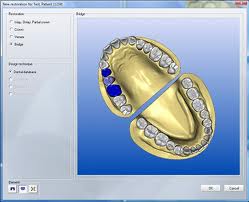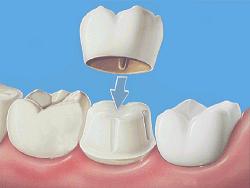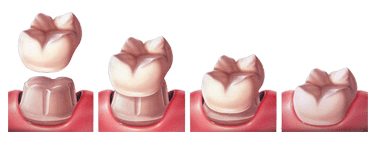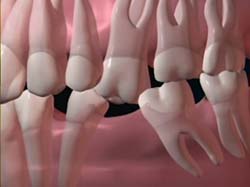| Restorative Treatment
CROWNS
With our State of the Art Single Appointment CEREC system, we can accomplish in one visit what used to take two visits. Traditionally, it has taken two appointments to restore a tooth with a crown. In the first any decay was removed from the tooth and then it was shaped to accept the crown. Then an impression was made of the tooth and a temporary crown was placed. The temporary crown often broke or came out during the almost 3 weeks it took for a lab to make a crown. In the second visit this temporary was removed and the permanent crown adjusted as needed and then cemented in place. With the CEREC system, we can fabricate Crowns, Inlays or Onlays all in one appointment, all while you are still anesthetized. A powerful laser camera takes pictures of your teeth and Drs. Mozer and Cuttler custom design each and every crown chairside. In just a few minutes computer-controlled diamond burs cut a solid block of porcelain into the exact spoecifications of your crown. The crown is then bonded in place to complete the procedure. CEREC System Crown Fabrication Software
Crown preparation Crown is Inserted and Bonded in Place
BRIDGES This is an option for filling the space created by a missing tooth or teeth. It is formed to look like the missing tooth. The bridge is basically 3 or more crowns that are fused together to bridge a missing tooth space. The sides of a bridge use the two surrounding teeth for support, hence the name. A bridge replaces the missing tooth, both functionally and cosmetically. Bridge work is as much an art as it is an exact science. The materials used may be porcelain bonded to metal alloy or all ceramic material. The choice of material depends on requirements for strength, wear, and/or esthetics. 3-Unit Bridge Drifting and Shifting of Teeth Whether by Implant or Bridge, it is important that a missing tooth be replaced as soon as possible for several reasons. If not treated, the teeth surrounding the gap begin to shift inward toward the missing tooth, creating a chain reaction. Teeth use their neighbors for support, and, with one missing, they start to shift. As this worsens the bite changes in response to the pressure. This can eventually result in problems with the entire jaw joint such TMJ. The surrounding teeth deteriorate and it is just a matter of time before Gum disease becomes a serious problem, with the difficulty of treatment increasing as the neglect continues.
IMPLANTS Dr. Paul S. Mozer is a member of the American Academy of Implant Dentistry and keeps his skills current through continuing education in implantology. A dental implant is an option to replace a missing tooth. In this procedure, a small titanium implant is surgically implanted into the bone and allowed to heal. The bone grows around it forming a tight connection, which additionally slows or stops the bone loss that occurs when the root of a natural tooth is missing. Once the implant is firmly healed in the mouth, Dr. Mozer or Dr. Cuttler then work to attach the replacement tooth onto the top of the implant. New advances in implantology can allow for immediate crown placement on the implant. This permanent solution has differs from a bridge in that adjacent teeth do not need to be filed down or adjusted and it does not stress the surrounding teeth for support. Implants are also an excellent option to stabilize a loose denture for a more permanent and secure attachment.
FILLINGS Fillings are done to remove decay, and replace the affected tooth structure. It is called a filling because new a material fills a hole that decay created. Today, most teeth are treated with bonded tooth colored composite resin fillings. Caught early enough, cavities can be treated easily and comfortably.
BONDING Bonding involves adhering composite resin material to the front of the tooth that is matched to the color of the surrounding teeth. This is done to repair damage done to the tooth by decay, to alter the alignment of the tooth, close gaps between the teeth, or for cosmetic purposes. First the surface of the tooth is roughened in order to accept the bonding and hold it in place. A gel is applied to micro etch the tooth surface, and a primer/bond agent is applied so the material adheres to the surface. Then the material itself is placed on the tooth and hardened with an LED light. The composite resin material is then shaped and polished to get a lustrous finish.
SEALANTS This is used to fill in narrow grooves in a tooth that cannot be adequately cleaned by brushing. In some cases, the tooth structure has fine grooves or pits which accumulate plaque, not because the person doesn't brush, but because they're too narrow to allow even one bristle into them. These will develop cavities over time. Dr. Mozer or Dr. Cuttler will brush on a coating that seals the grooves and pits, making it possible to brush off all the plaque and keep your teeth healthy.
NON-SURGICAL GUM TREATMENTS
ROOT CANAL TREATMENT Root Canal treatment (also referred to as root canal therapy or endodontic therapy) is made necessary when a cavity is allowed to reach all the way to the nerve of the tooth. Sometimes deep restorations or trauma to a tooth may cause the nerve to be damaged to the point it needs root canal therapy also. Once this occurs the pulp becomes infected, and this infection can extend through the root tip and begin to infect the surrounding bone (this is an abscess). By the time the nerve is infected it must be treated, and cannot heal on its own. It can even weaken the entire immune system. Symptoms that the nerve has become infected may include sensitivity to hot/cold or sweets, pain, swelling, pain to biting or pressure, and a bad taste in the mouth. Sometimes, however, no symptoms are apparent and the person is unaware of any problem until a checkup. Regular cleanings and checkups prevent and detect problems early. A root canal is then performed to clean out the infected nerve and disinfect the nerve canals of the tooth. Once the infection is resolved, the canal(s) are filled in to prevent any further infection. Usually a core build-up and crown is recommended for restoring a tooth that has had root canal therapy. The only other treatment for an infected nerve would be to extract the tooth. |






